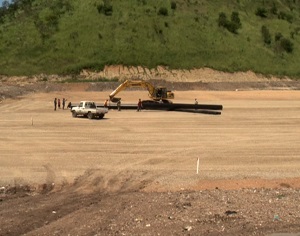by Tokana Hasavi – EM TV, Port Moresby
When you finish your meal at a food bar, you throw your leftovers into a litter bin and you don’t think about that waste again.
On rubbish pickup days in your neighbourhood, you put your garbage by the street and workers dump the contents into a big truck and tow it away.
You don’t have to think about that waste again, either. But perhaps you have wondered, as you watch the rubbish truck pull away, just where that garbage ends up.
If you reside in Port Moresby City, Baruni Dump is where it ends up. In fact, it is the final resting place for most of the city’s solid waste. Here is some insight into the rehabilitation process of Baruni Dump, which now uses a world-class sustainable system to contain its solid waste.
Baruni Dump was established in the 1980s, but was completely inefficient, with no tangible functional system to ensure a sustainable lifespan, which consequently caused real environmental and social hazards. In 2011, the National Capital District Commission (NCDC), the Japanese government and relevant counterparts, instigated a revamp of Baruni Dump.
What used to be an unsystematic area of environmental and social hazards is quickly changing into a world-standard landfill that is environmentally-friendly. Amano Shiro from the Japanese International Cooperation Agency (JICA) is chief advisor of the Baruni Revamp Project and he says Baruni needed the upgrade.
“Solid waste management is highly important, but the issue of Baruni was neglected in the past. It is good that authorities have now put it as a priority issue and Japan is here to mainly dispatch expertise and training to develop capacity,” said Shiro.
NCDC Waste Management Manager Joshua Sam, says the Baruni Revamp Project could not have come at a better time.
“The capital city’s population has increased tremendously in conjunction with infrastructure growth, effectively putting a strain on the space for solid waste management. According to NCDC, the population of NCD has increased from 4,000 in 1946, to close to one million today.
“The revamp of Baruni is fully funded by NCDC at the cost of K12 million and will be implemented through two phases scheduled for completion at the end of 2015, or early 2016,” explained Sam.
In 2012, Baruni Dump ingested an estimated weight of between 27,000 to 50,000 tonnes of solid waste. Today, according to NCDC Baruni Revamp Project Engineer James Ricky, that estimated mass has increased four times over; Baruni Dump is estimated to take in over 200,000 tonnes per year.
“In 2024, the projected volume of solid waste ingested by Baruni will be over 100 tonnes per day and that is sure to cause a major challenge for the city’s landfill,” said Ricky.
Baruni Dump will now be known as the Baruni Sanitary Landfill, adopting a system used in Japan.
Mr Ricky says the system, called the ‘Semi-Aerobic Landfill type’, or commonly tagged as the ‘Fukuoka Method’, takes after Fukuoka City in Japan and is conducive for PNG’s topography.
Rubbish will be disposed on rocks in a massive, open crater. Beneath the rocks, ventilated piping will efficiently trap and release methane and carbon dioxide into the air. The gases are formed through chemical reactions that allow oxygen to break down solid waste, with the aid of micro-organisms.
The production of leachate, which is the black liquid from garbage, is also accounted for and will be filtered through the system into a leachate pond away from the rest of the soil, particularly away from groundwater, which is what makes this system locally, socially and environmentally friendly.
The first of the two phases of construction is the completion of two giant, rectangular craters known as ‘cells’ one and two. According to the city’s current rate of solid waste, one rectangular crater will absorb over 400,000 cubic metres of rubbish for five years upon completion.
When the cells have reached their capacity, they are then covered with fresh soil, ultimately becoming mini-hills; another crater is then built – and the cycle continues. But the need for more land is vital. NCD’s population has grown from about 4,000 in 1946 to over a third of a million today.
This growth, combined with a rapid increase in public and commercial infrastructure, requires an expansion of this landfill. The main purpose and biggest challenge of the Baruni Sanitary Landfill is to contain the rubbish so that it doesn’t cause problems in the environment like it once did.
The revolutionary system in place now prevents rubbish from coming in contact with outside soil, particularly groundwater. The first phase of this K12 million project is expected to be completed by the end of this year’s first quarter, while phase two is expected to be complete at the year’s end.
https://youtube.com/watch?v=0YVQrDs7xvg%3Ffeature%3Doembed%26wmode%3Dopaque%26showinfo%3D0%26showsearch%3D0%26rel%3D0


